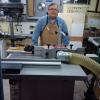
Originally Posted by
Rod Sheridan

Kev, you can't simply move the 5 to the other side of the equation.
You can do the same thing to both sides of the equation, and keep the validity of the equation.
In other words you can add -5 to both sides of the equation, or subtract +5 from both sides. Obviously that's the same result, a different "visualization" is all.
It's pretty obvious to you because you've mastered the skill and don't have to write it down, however what you are really doing is adding -5 to both sides of the equation............Rod.
+1.
That is why we do the common core stuff. Unknowingly, you did the 5-5 in your head, without realizing it. But we want the students to realize it... so when they have more complex problems they will recall that they were able to isolate variables by performing identical functions on each side of the equation and still have an equality.
Comments made here are my own and, according to my children, do not reflect the opinions of any other person... anywhere, anytime.





 - fiber lasers
- fiber lasers
 Reply With Quote
Reply With Quote






